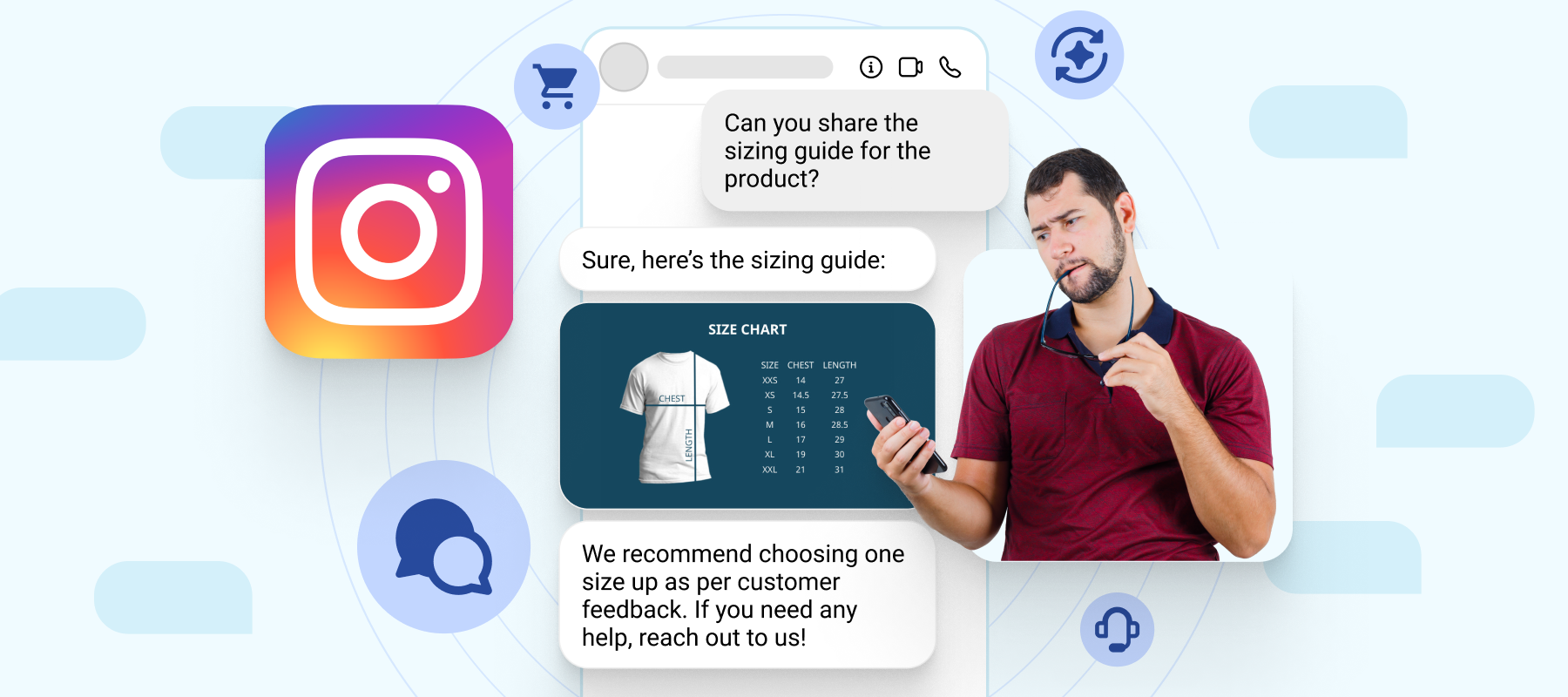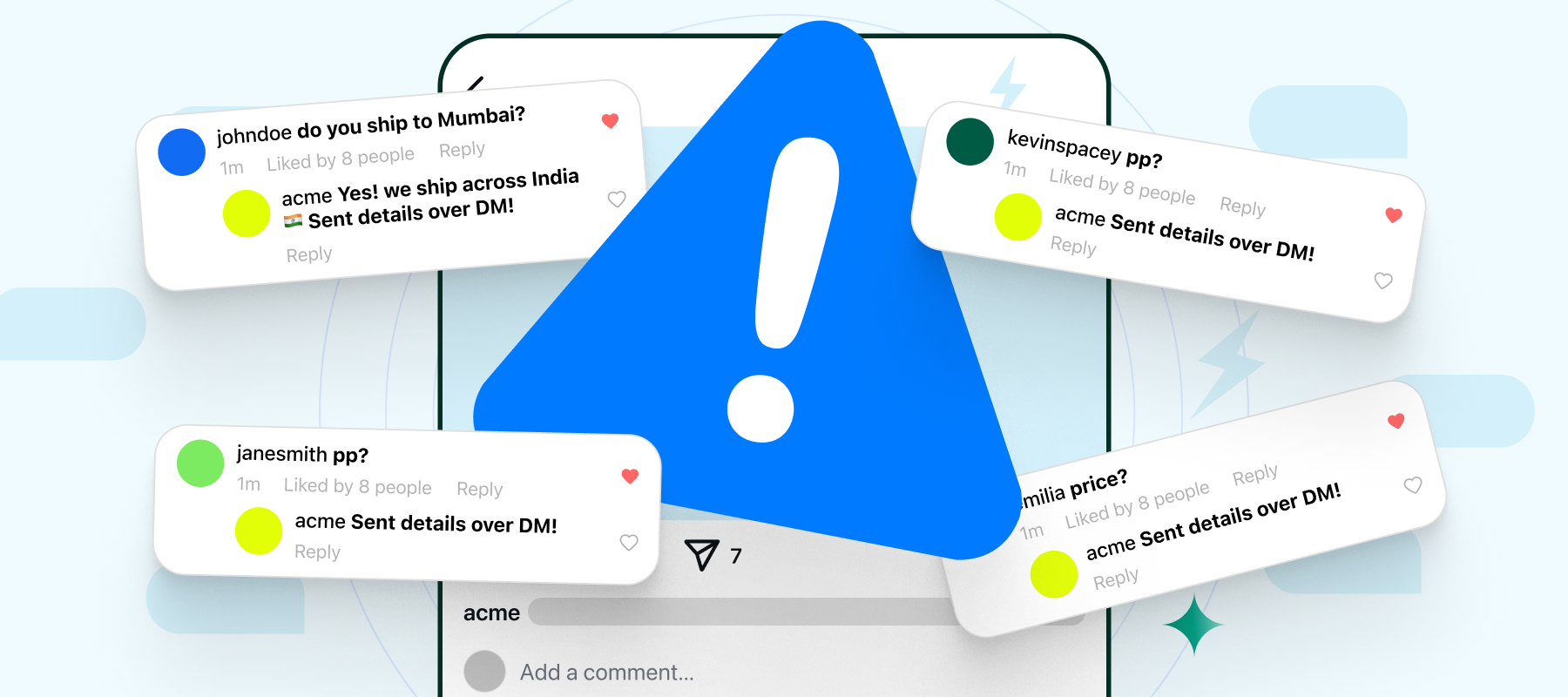Instagram isn’t just about reels and pretty pictures anymore.
With billions of monthly active users, it has become a space where people scroll, engage, shop, and interact with businesses.
As a result, it has naturally become a popular channel for customers to ask questions, share concerns, and seek quick support.
However, for businesses, adapting to this shift hasn’t been easy.
The main challenge lies in manually managing a high volume of direct messages, which can quickly become overwhelming and time-consuming. This is where automation offers a practical solution.
In this post, we’ll explore how you can automate your Instagram automation to respond faster, manage conversations more efficiently, and deliver a better customer experience
Understanding Instagram DM Automation
Instagram DM automation is the process of setting up automatic replies to direct messages using specific tools or built-in features.
Instead of replying to every message manually, businesses can use automation to respond instantly, guide conversations, and easily manage high volumes of customer queries. This saves time and ensures no message goes unanswered even outside working hours.
Types of Automated DMs
Below are the main types of automated DMs you can set up:
1. Instant replies
These are sent the moment someone messages your page. The goal is to acknowledge the message immediately and let the person know their query has been received.
For example, “Thanks for reaching out! We’ve received your message and will get back to you shortly.” Instant replies help set expectations and show the customer you’re on it.
2. Greeting messages
Greeting messages are triggered when someone starts a conversation with your business for the first time or after a long break. They’re perfect for setting the tone and making a positive first impression. A typical greeting might be,
“Hi there! We’re glad you’re here. How can we help you today?”
3. Action-triggered messages
These messages are sent based on specific actions taken by the user. For instance, if someone replies to a story, clicks a button, or uses a keyword in their message, you can set up a relevant automated response. This helps keep the interaction timely and tailored to the user’s behavior.
Benefits of Automating Instagram DMs
Here are some benefits of automating Instagram DMs:
-Improved response times: 90% of customers expect an immediate reply. With automation, you can reduce your response time by 50%, delivering faster and more efficient resolutions.
-Enhanced customer satisfaction: We’ve found that automation cuts down wait times and speeds up resolutions, resulting in a 25% increase in customer satisfaction.
-Efficient handling of FAQs: 59% of customers prefer solving simple issues without speaking to an agent. Automating your DMs allows them to resolve repetitive queries independently, reducing your team’s workload and cutting support costs by 30%.
–Lead generation and qualification: Automated conversations can capture, segment, and nurture leads without manual effort, leading to a 451% increase in qualified leads.
Setting Up Automated Instagram DMs
Getting started with Instagram DM automation doesn’t have to be complicated. You have two main options, depending on how hands-on or advanced you want the setup to be:
1. Instagram’s built-in features
Instagram provides a few built-in tools for basic automation, available to professional accounts:
-Quick Replies for answering common questions with saved responses
-Away Messages to automatically respond when you’re unavailable
-FAQs that let users tap and get instant answers to frequent queries
These features are simple to set up and ideal for handling repetitive messages. However, they come with limitations in terms of scale, customization, and workflow flexibility. They work best for small businesses or early-stage brands with minimal support demands.
2. Third-party automation tool
For more control and advanced automation, third-party platforms are the better choice.
Tools like Interakt let you build smart DM flows, segment leads, send personalized replies, and even hand off conversations to live agents when needed. You can:
-Set up auto-replies based on keywords
-Trigger different responses depending on user actions
-Collect customer data directly through DMs
-Integrate with your CRM, WhatsApp, Shopify, and more
If you’re handling high volumes of messages or looking to turn Instagram into a full support or sales channel, platforms like Interakt make automation simple, scalable, and seamless.
Step-by-Step Setup Guide
Automating your Instagram DMs starts with the right setup. Follow these steps to build a system that saves time, improves support, and keeps your inbox under control.
1. Setting up Instagram business account & API access
To begin, switch your Instagram profile to a Business Account. This gives you access to professional tools required for automation. Next, connect your Instagram account to Meta Business Suite to manage your messaging and settings. Finally, enable API access, which allows automation tools to interact with your Instagram account securely and effectively.
2. Defining customer support workflow
With your account ready, the next step is to define how support should work. Identify common customer queries like order status, returns, or product details and map out clear, automated responses for each. Also, decide how and when to escalate more complex issues to a human agent for personalized support.
3. Creating automated responses & quick replies
Now that you’ve outlined your support flow, start creating a set of predefined responses for FAQs to streamline support. Use keyword-based triggers that detect what the customer is asking and send the appropriate reply automatically. To make your responses feel more natural, include personalization elements like the customer’s name or order info where applicable.
4. Integrating Instagram with CRM & helpdesk tools
Connect Instagram to your CRM or helpdesk software such as Zendesk, HubSpot, or Freshdesk. This allows all customer interactions to be tracked and managed in one place. Integration ensures better coordination across teams and gives you a complete view of the customer journey.
5. Implementing chatbots & AI-powered responses
Set up AI-powered chatbots to provide real-time assistance for incoming DMs. Configure the bots to understand and respond to common inquiries accurately. Continuously train the chatbot using customer interaction data to improve its accuracy and performance over time.
Best Practices for Effective DM Automation
Here are some best practices for effective DM automation:
1. Personalizing Automated Messages
Use the customer’s first name in your replies by pulling their profile info through your automation tool. Reference their last interaction or order status where possible. Avoid generic phrases, and make each message feel like it was written for them. Example: “Hey [First Name], here’s the tracking link for your recent order!”
2. Maintaining a Human Touch
Use a friendly, conversational tone in your automated replies. Avoid robotic or overly formal language. Always include an option like “Talk to a real person” or “Need help from our team?” in your flows to make it easy for users to reach a human when needed.
3. Monitoring and Adjusting Automation
Set a weekly routine to review automation performance, look at response times, drop-off points, and unanswered questions. Use insights to tweak replies, update triggers, or add missing FAQs. Also, test the flows every few weeks to catch anything that feels off or outdated.
Potential Pitfalls and How to Avoid Them
While automation offers huge advantages, there are a few common mistakes to watch out for. Here’s how to avoid them and keep your strategy effective:
1. Over-Automation Leading to Impersonal Interactions
When everything is automated, conversations can feel cold or generic. To avoid this, only automate repetitive or low-complexity queries.
Include personal elements like the user’s name or relevant context in your replies. Most importantly, make sure there’s a clear option to speak with a real person. This balance keeps your automation efficient without losing the human touch.
2. Ensuring Compliance with Instagram’s Policies
Using unapproved automation tools or overstepping API limits can result in account restrictions or bans. Always use official or Instagram-approved platforms that comply with Meta’s API guidelines.
Avoid sending unsolicited messages, spamming users, or automating in ways that violate Instagram’s terms of service. Stay updated on platform rules and review any automation tool’s compliance policies before integrating.
Case Studies: Successful DM Automation
Coding Stella, an EdTech platform known for coding tutorials, faced challenges managing high volumes of Instagram DMs and repetitive queries, which led to delayed responses and reduced engagement.
By implementing Interakt’s Instagram Automation, they automated common replies like the “Price Please” response across DMs and comments. This led to a jump in followers from 500k to 511k+ in just one month, and saved 2–3 hours daily previously spent on manual replies.
The result was faster engagement, improved customer experience, and more time to focus on content creation and product sales.



